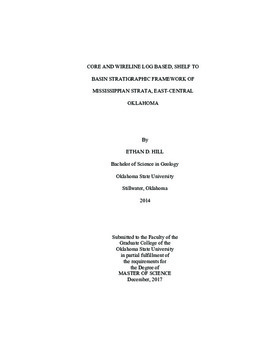| dc.contributor.advisor | Puckette, James | |
| dc.contributor.author | Hill, Ethan D. | |
| dc.date.accessioned | 2018-06-18T17:30:02Z | |
| dc.date.available | 2018-06-18T17:30:02Z | |
| dc.date.issued | 2017-12-01 | |
| dc.identifier.uri | https://hdl.handle.net/11244/300107 | |
| dc.description.abstract | The “Mississippian Limestone” of the Mid-Continent contains a geologically complex organization of facies and is an areally extensive mixed carbonate-siliciclastic system. Lateral and vertical heterogeneity commonly occurs within carbonates and has been illustrated within the Mississippian Subsystem of the Mid-Continent. These facies shoal upwards from siliciclastic dominated facies (argillaceous siltstones/sandstones and silty shale) into progressively more carbonate-dominated facies (burrowed mudstones-wackestones), and conclude in mud-lean packstones-grainstones. Facies and sedimentary structures from core and thin section analysis, along with bed geometries (observed within the study area) suggest deposition within the distal mid-ramp to outer ramp region of a distally-steepened ramp during fluctuations in sea level with occasional influence from storms.Previous studies on the “Mississippian Limestone” have focused on larger scale variations in lithofacies. More recent work has identified a sequence stratigraphic hierarchy of facies changes due to variations in sea level. While recent studies have focused on proximal locations of the ramp, little work had been done within the more distal portions of the ramp. This study shows the stratigraphic relationship between more distal facies and the proximal facies in the Mississippian section within the study area. This work is important, as it builds upon previous work (LeBlanc, 2014; Bertalott, 2014) and demonstrates the stratigraphic relationship between proximal carbonate-rich facies and distal siliciclastic-rich, argillaceous facies. Bertalott (2014) demonstrated that prograding carbonate wedges in a ramp setting were a logical interpretation of Mississippian depositional packages within the northern part of the study area. This study tested the hypothesis that prograding carbonate wedge geometries extend into a more basinal depositional setting by expanding upon previous studies with subsurface data from Creek and Lincoln Counties, Oklahoma and employing a sequence stratigraphic framework, this study extended the ramp model basinward and identified associated siliciclastic dominated depositional facies. | |
| dc.format | application/pdf | |
| dc.language | en_US | |
| dc.rights | Copyright is held by the author who has granted the Oklahoma State University Library the non-exclusive right to share this material in its institutional repository. Contact Digital Library Services at lib-dls@okstate.edu or 405-744-9161 for the permission policy on the use, reproduction or distribution of this material. | |
| dc.title | Core and Wireline Log Based, Shelf to Basin Stratigraphic Framework of Mississippian Strata, East-central Oklahoma | |
| dc.contributor.committeeMember | Coffey, William | |
| dc.contributor.committeeMember | Grammer, Michael | |
| osu.filename | Hill_okstate_0664M_15581.pdf | |
| osu.accesstype | Open Access | |
| dc.description.department | Geology | |
| dc.type.genre | Thesis | |
| dc.type.material | text | |
